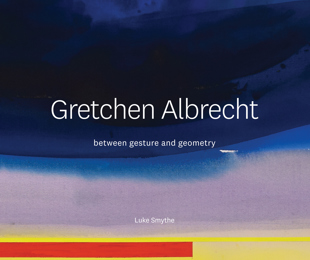Catharina van Bohemen speaks with Gretchen Albrecht about Gretchen Albrecht Revised Edition: Between Gesture and Geometry by Luke Smythe:
‘In 2019, Gretchen Albrecht – Between Gesture and Geometry, published by Massey University Press, was launched at Auckland Art Gallery Toi o Tāmaki. Written by Luke Smythe, it is a monograph of Gretchen Albrecht, whose dedicated practice has enriched and illuminated our country’s art for over 60 years.
The Gallery holds at least seven of Albrecht’s major works, including Aotearoa – Cloud, 2002, and Gains and Losses (Father – Red), 1998, and has held two solo exhibitions over the years: Seasonal/Four Paintings (1985–86), and Gretchen Albrecht: Illuminations (2002).
The Covid years, with their insistence on solitude and containment, prompted Gretchen to reconsider themes and structures in her work from the perspective of a painter with a long view. During those years, she completed two suites of paintings: After Goya, 2020, four large hemispheres ‘talking’ to four portraits by Goya, which reaffirmed her kinship with the Western art tradition, and Eight Hours, 2019–21, a meditation on the eight hours of the Divine Office, prayers sung throughout day and night in monasteries since medieval times which honour time’s eternal present.
The significance of these series was recognised by author and publisher, and in 2023, a revised edition of the monograph with a new cover and a final evocative chapter, ‘Time’s Measure’, was launched at Two Rooms Gallery.
Catharina van Bohemen spoke to Gretchen Albrecht about working with Luke Smythe, how she paints, and the importance of After Goya and Eight Hours.
CvB: How did the idea for a monograph come about, and what part did you play in its development?
GA: For about four or five years when he was a university student, Luke was my technical assistant and got to know my work intimately. He began by going through boxes of 35 mm slides and set up a digital database for my archive. Gradually, he became more technologically expert, and I also got hold of better images of my paintings. For instance, if one came up for auction, or we knew somebody who owned a work, we sent a photographer to record it. Nikki, my present studio assistant, still works on that archive today.
Luke suggested the monograph and that he’d like to do it. He also seemed the right choice. He'd looked at my work for so long – his parents own a ‘hemisphere’ which has always hung in their various houses; he'd written essays for New Zealand journals and catalogues; and when Jamie [Gretchen’s husband, artist James Ross] and I went to America in 2000, and took a show to a dealer gallery, he wrote the essay for that.
I gave him access to whatever he wanted. He looked at my paintings in storage which holds work from 1963 to now. He went through all my archive boxes, my correspondence, my studio notebooks; in fact, whatever he wanted.
How much a part do I play in the book? Well, how long is a piece of string? Obviously, when he was writing, I wasn't breathing over his shoulder. His writing about the Illuminations series, 1977–78 is incredible. They are not my words but his. I loved what he found and how he wrote about it. He surprises me with his readings and interpretations.
Part of the aim of my recent show, Lighting the Path at Two Rooms (November–December 2023) was to bring the 45-year-old Illuminations paintings, which I’d painted before going to Europe in 1978, into focus with the work I produced in 2023, to see correspondences and how the language I established long ago is still used for new sentences now. There were enormous shifts after being in Europe, and when I came back, those paintings didn’t seem relevant. That’s why they remained rolled up. But that's good, because if I hadn't gone away, and had exhibited them, they’d all be scattered – not seen as this core group that I saw when I unrolled them two years ago.
I played a part in the book that any person being written about would play with her author. If Luke said something that I felt needed fleshing out a bit, I might say, for example, ‘Well, we were walking through the Louvre in 1980, and suddenly I saw Mantegna’s Madonna della Vittoria with this amazing garlanded arch above her. And I’d said to Jamie, “This must have just arrived in the Louvre!”’
It hadn’t. It had been there for years. It was invisible to me until I needed to see it.’
Read the full interview here.


